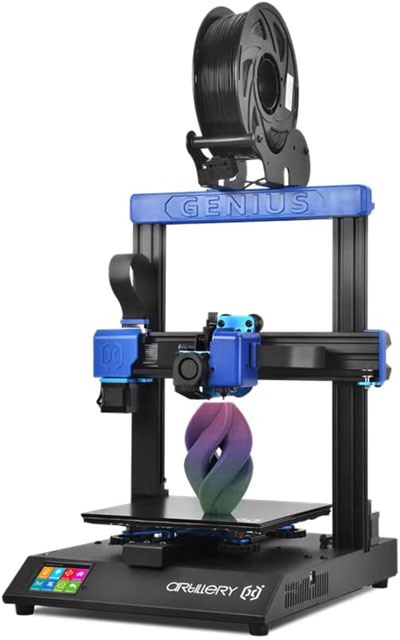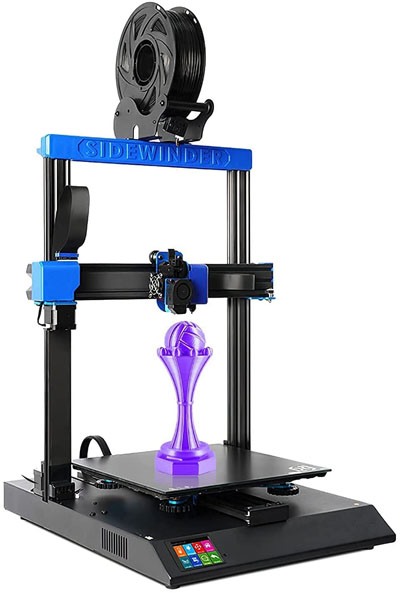Artillery offers two desktop FFF 3D printers, the Genius-Pro and the Sidewinder X2. Both printers offer exceptional features. We are going to compare the two based on build volume, safety, and stability. We will base our recommendation on project needs as this will be the biggest deciding factor between the two models.
Artillery Genius-Pro
The Genius-Pro is a desktop FFF 3D printer offering a vast amount of features. It features automatic bed-leveling, a fast-heating print bed, and protection against many safety risks.
Auto-leveling
While the company makes claims that auto-leveling will take care of all of the user’s leveling needs, this is not completely true. Probes do take care of fine-tuning the printer’s leveling, but they do not take over the entire process. Touch probes make a 9-point digital mesh to maintain a consistent distance from the build plate at all times. Users will still find that they have to use paper as a gauge under the nozzle while turning some knobs. However, the printer does take over the fine-tuning.
Proprietary Z-coupler
Artillery offers proprietary Z-couplers that strengthen the Z-axis. These couplers eliminate any layer problems that might occur during printing. The Genius-Pro has an aluminum casing surrounding the Z-coupler, strengthening the system’s rigidity. It also offers a dual Z-axis with a double screw drive. This offers more stability, speed, and precision during printing.
Fast Heating
The Genius-Pro features a quick-heating glass AC print bed. In under two minutes, it reaches a temperature of 80°C. In just one more minute, it will reach its maximum temperature of 120°C. This allows for printing to start more quickly as the first layer can be put down faster. The hardness and even heat distribution of the print bed offer easy extraction as well as minimal warping.
The printer comes equipped with a volcano nozzle. This means that the filament will quickly and evenly extrude and printing will be of the highest precision. The nozzle has a maximum temperature of 240°C.
Other Features
The Genius-Pro comes with a filament run-out sensor and a power loss print recovery option. This will prevent prints from being ruined if the filament runs out or the power cuts off.
The Genius-Pro offers a gamut of safety features as well. It protects against excess temperature, overcurrent, short circuits, overvoltage, and other safety risks.
It also has a colorful touchscreen UI. This UI is intuitive and responsive.
The Genius-Pro offers a build volume of 220 x 220 x 250 mm. Layer resolution is 0.1 to 0.35 mm. Print speeds are 60 to 150 mm per second while travel speed is 250 mm per second.
The printer has a single extruder with a filament diameter of 1.75 mm. Supported filament types include PLA, flexible PLA, wood, HIPS, ABS, and PVA. XYZ resolution is 0.05 mm, 0.05 mm, and 0.01 mm.
Artillery Sidewinder X2
The Sidewinder X2 is an FFF 3D printer. It offers many features, including a volcano-style nozzle, a fast-heating print bed, and a large build volume.
Like the Genius-Pro, the Sidewinder X2 offers a volcano nozzle. Both printers also offer an AC fast-heating print bed.
Unlike the Genius-Pro, the Sidewinder X2 does not feature extra Z-axis support. It experiences significant wobbling on this axis. The Sidewinder X2 also has a much larger build volume of 300 x 300 x 400 mm.
Safety
This printer comes with robust cable support. The heat plate cable is encased in a rubber sleeve that goes through a channel in the printer’s base. Additionally, all gantry connections arrive pre-assembled, ensuring that the cables are in good condition.
Extruder and Nozzle
This printer features a Titan-style direct drive extruder. This allows for the use of flexible filaments like TPU. The hot end is volcano-style. This enables the filament to quickly and evenly extrude.
Quiet Printing
The Sidewinder X2 comes with ultra-quiet stepper drivers. These drivers provide printing at low decibels even when the printer is working at fast speeds. Additionally, it features a 32-bit Ruby mainboard. This offers high stability and expandability.
Patented Z-coupler
Featuring a synchronized dual Z-axis design, a closed-loop synchronous belt, and a double leadscrew, the printer delivers synchronizing performance. The patented Z-coupler eliminates any layer pattern problems, offering better printing quality.
Automatic Print Resume Function
Before the filament runs out, the printer will notify the user with an alarm. This allows the user to replace the filament, preventing air printing.
If there is a power failure or the machine cuts off, the printing will pause. As soon as power is restored, printing will resume at the exact spot it paused.
AC Heat Bed
The Sidewinder X2 features an AC heat bed that offers decent thermal conductivity for fast heating. The bed can heat to 110°C as quickly as two minutes. Working in combination with the tempered glass platform, this allows for smoother printing with great adhesion.
Other Features
There is no need to deal with manual bed leveling. The Sidewinder X2 has matrix automatic bed leveling technology.
The printer has a print speed of 60 mm per second to 150 mm per second. Its single extruder has a filament diameter of 1.75 mm. It also features an aluminum extrusion frame and ABL calibration.
The filament types that the printer supports include PLA, wood, PVA, ABS, HIPS, and other flexible materials. Its XYZ resolution is 0.05 mm, 0.05 mm, and 0.1 mm.
The volcano nozzle has a diameter of 0.4 mm. Its temperature is 180 to 240°C. Its heating time is less than three minutes. The build plate reaches 80C in less than two minutes.
Our Recommendation
Both printers offer a magnitude of excellent features; however, we must delineate between the differences so that users can make a selection between the two. The Genius-Pro offers great safety features as well as automatic bed leveling, an AC heat bed, and extra Z-axis support. We recommend it for entry-level and seasoned makers.
On the other hand, the Sidewinder X2 offers a larger build volume in addition to automatic bed-leveling and an AC heat bed. We recommend this printer for anyone looking to purchase a large format printer. It would also be good for entry-level and seasoned makers.

